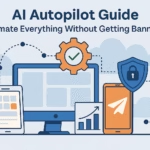- Freedom starts with structure. Map your workflow first so automation has a clean path.
- AI business automation is discipline. Small clean loops create compounding momentum.
- Start small, scale calm. Automate one loop at a time before adding more.
- One dashboard beats ten tabs. Centralization removes confusion and creates rhythm.
- Blaze Autopilot connects the flow. Posting, emails, leads, and reporting in one place so your business does not pause when you do.
The 60-Day Experiment
Most entrepreneurs talk about “scaling with AI,” but few can show what that actually looks like once you switch the machines on. I decided to stop reading about it and run the test myself a 60-day deep dive into AI business automation. The goal wasn’t hype. It was survival.
Before automation, every task pulled at me like static: writing posts, replying to leads, checking analytics, chasing invoices. None of it built momentum; it just maintained chaos. I wanted to see what would happen if every predictable task ran itself for two months straight.
By day ten, something clicked. My inbox still filled up, my audience still grew, but my calendar stayed empty. This is what real AI business automation feels like quiet efficiency.
The rest of this article breaks down what changed, what failed, and what you can duplicate without needing a full team or fancy background.
Week 1-2: Mapping the Chaos
Before I could automate anything, I had to face the mess. Most people skip this step because it feels boring. But mapping your business before automation is like cleaning the kitchen before cooking otherwise, everything burns.
I listed every recurring task across four areas: content, email, leads, and analytics. Then I tracked how much time each one stole. The result looked like a ransom note from my own schedule.
Here’s what the transformation looked like when the dust settled:
| Area | Before Automation | After Setup |
|---|---|---|
| Content | Scattered posts, inconsistent timing | Auto queued posts aligned with analytics |
| Emails | Manual broadcasts every few weeks | Automated drip for new leads |
| Leads | Lost in DMs and spreadsheets | Centralized CRM with tags and triggers |
| Analytics | Multiple dashboards and manual reports | Unified performance report weekly |
That simple audit revealed where automation would make the biggest dent. I wasn’t trying to digitize creativity; I was cutting out repetition.
Once you see your workflow on paper, it stops being mysterious. You know exactly what to delegate to the algorithm next.
Week 3: Building the Autopilot
By week three, the goal was no longer saving time. It was removing decisions. I started connecting my daily routines to a single control panel one that could post, email, track, and report without my constant touch.
This is the core truth of AI business automation: the more predictable a task, the easier it is to automate. The trick is starting small. I began with three layers content, communication, and analytics.
-
Content automation handled my posting rhythm. I set up queues based on engagement data instead of guesswork.
-
Communication automation handled my audience follow-ups and onboarding drips. No one slipped through the cracks.
-
Analytics automation replaced my endless spreadsheet reports with weekly summaries that landed in my inbox.
Here’s the structure I built to keep it simple:
| Layer | Purpose | Example Task |
|---|---|---|
| Content Automation | Maintain daily visibility | Auto schedule Instagram and blog posts |
| Communication | Keep audience warm | Send welcome email, follow ups, reminders |
| Analytics | Measure and adapt | Weekly performance report with insights |
Once these layers synced, my role shifted from operator to observer. The system told me what needed attention instead of me chasing it.
If you’re wondering how all this connects from one dashboard, this platform (Blaze Autopilot) does exactly that. It centralizes posting, emails, and reporting so your data stops living in ten different tabs.
Week 4–5: Letting Go of Control
The hardest part wasn’t setup. It was stepping back. I was used to checking analytics ten times a day, writing captions manually, and refreshing dashboards like it made the numbers change. When the system took over, I didn’t know what to do with myself.
But that’s where automation really starts to work in the quiet. I spent those two weeks learning how to trust the flow instead of micromanaging it. I checked once a day instead of every hour.
My engagement stayed steady, my leads actually increased, and my stress levels dropped like a rock.
Here’s what surprised me: the more space I gave the system, the smarter it got. My posting times refined themselves, my open rates improved, and even my reports started predicting trends before I saw them coming. That’s when it hit me control isn’t productivity. It’s resistance.
The lesson here is simple: automation doesn’t erase your presence, it multiplies it. The more you step back, the more your systems perform as designed. You go from reacting to refining.
That’s the turning point most founders never reach, because they can’t stop touching the wheel long enough to see how smooth the ride can be.
Week 6: Results and Reality
By the end of the sixth week, I wasn’t sure if I was running a business or watching one. The system had found its rhythm. Posts went live on schedule. Emails landed exactly when people were most likely to open them.
Reports arrived every Monday with insights so clear, I could make decisions in five minutes instead of fifty.
Here’s what the numbers said the calm wasn’t just emotional, it was measurable:
| Metric | Before Automation | After 60 Days |
|---|---|---|
| Weekly Hours Worked | 42 | 14 |
| Content Output | 5 posts a week | 12 posts a week |
| Email Open Rate | 18% | 39% |
| Monthly Revenue | $3,200 | $5,100 |
The real gain wasn’t the revenue spike. It was predictability. Every moving part content, communication, analytics ran on time without my approval. I wasn’t checking on the system anymore; I was checking what it produced.
That’s what AI business automation actually delivers when done right: not magic, but rhythm. It gives you the same consistency a team would, without the payroll.
What I’d Do Differently
Automation doesn’t mean perfection. A few things broke, and some still need a human touch.
First: I tried to automate everything too early. My DMs were replying faster than I could process them, which made some conversations feel robotic. Lesson learned not every message needs instant response.
Second: I underestimated the creative layer. The system handled timing, captions, and reports beautifully, but ideas still need a human spark. AI can execute, not inspire.
Third: I ignored data feedback for too long. Once I started checking weekly reports again, I realized small tweaks had massive ripple effects like posting fewer times but during high-intent hours.
If I could redo it, I’d focus on building one clean loop first-content → engagement → report → adjust-before stacking extra automations. The strength of AI business automation lies in its simplicity, not its speed.
That’s where Blaze Autopilot shines. It brings every layer content, email, and reporting into one environment so you can scale from clarity, not clutter.
The Blueprint: From Manual to Automatic
You don’t need 60 days to build what I did. A week is enough if you start focused.
Here’s the exact roadmap I’d hand to anyone starting from zero no tech jargon, no overkill.
| Day | Action | Outcome |
|---|---|---|
| 1 | Map your workflow | See what to automate first |
| 2 | Connect your content channels | All platforms synced to one dashboard |
| 3 | Set up an email sequence | Leads get nurtured automatically |
| 4 | Tag and segment leads | Personalized follow ups |
| 5 | Build your weekly KPI report | Real feedback loop created |
| 6 | Run a dry test | Confirm timing and triggers |
| 7 | Launch your system | Business starts running itself |
Each day builds on the last. By the end of the week, you’ll have your own version of what I tested for 60 days a quiet machine that works while you plan your next move.
And the beauty is, this setup scales. Whether you’re running a small content brand or a multi-channel business, one automation hub handles the same logic.
That’s why founders who switch to Blaze Autopilot rarely go back. It centralizes everything that makes automation powerful control, clarity, and consistency without the noise.
The Quiet Win
The first morning I woke up to find my business had worked overnight, I didn’t feel excited. I felt suspicious. We’re trained to believe that progress equals exhaustion. When you finally remove the chaos, your brain doesn’t know what to do with the silence.
That silence, though, is where growth hides. When you stop doing busy work, you start building systems. When you stop chasing metrics, you start understanding patterns. And when your time isn’t swallowed by admin tasks, creativity finally gets space to breathe.
That’s the real win of AI business automation it doesn’t make you rich overnight, it makes you consistent forever. You don’t feel like a superhero. You feel balanced, precise, and quietly in control.
Most founders are still stuck trying to “scale harder.” The smarter ones scale smaller fewer tools, fewer distractions, one dashboard. Tools like Blaze Autopilot don’t replace ambition; they protect it.
If you ever wanted to know what freedom feels like while your business keeps earning, this is it. Automation isn’t the future anymore. It’s just the quiet present most people haven’t noticed yet.



